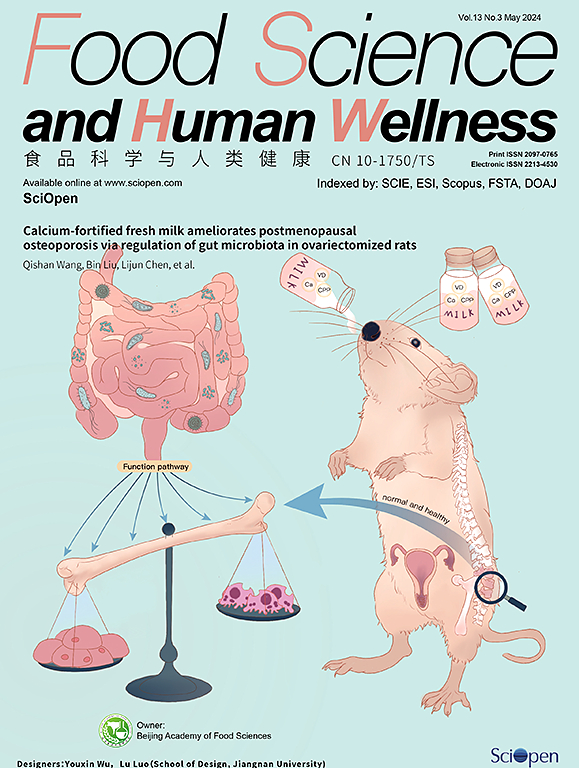Identification and the molecular mechanism of novel duck liver-derived anti-inflammatory peptides in lipopolysaccharide-induced RAW264.7 cell model
IF 7.4
1区 农林科学
Q1 FOOD SCIENCE & TECHNOLOGY
引用次数: 0
Abstract
In this study, 10 novel anti-inflammatory peptides were identified from duck liver, and their molecular mechanism was demonstrated based on machine learning and molecular docking. Using Sephadex G-15 gel chromatography separation, reversed-phase high-performance liquid chromatography purification, liquid chromatography-tandem mass spectrometry identification, and BIOPEP database comparison, 10 novel anti-inflammatory peptides were initially found. Their splendid angiotensin-converting enzyme (ACE) inhibition and anti-inflammatory properties were confirmed by machine learning. With binding energies less than –20.93 kJ/mol, molecular docking revealed that they could efficiently bind to the active pockets of tumor necrosis factor α (TNF-α), interleukin 6 (IL-6), cyclooxygenase 2 (COX-2), and nuclear factor κB (NF-κB) proteins with efficiency, indicating that the compounds can spontaneously form complexes through hydrogen bonding and hydrophobic interactions with the protein binding pockets. In the lipopolysaccharide-induced RAW264.7 cell model, the release of NO, TNF-α, and IL-6 and the mRNA expression of inflammatory factors (TNF-α, IL-6, COX-2, and NF-κB) were significantly inhibited by these peptides. We concluded it might be due to their anti-inflammatory effects by inhibiting the protein phosphorylation of inhibitor of NF-κB (IκBα) in the cytoplasm and preventing the translocation of NF-κB p65 in the cytoplasm to the nucleus, thereby regulating the NF-κB signaling pathway. This study is essential for the screening of anti-inflammatory peptides and the investigation of the mechanism of action.

在 LPS 诱导的 RAW 264.7 细胞模型中鉴定新型鸭肝源性抗炎肽及其分子机制
本研究从鸭肝中鉴定出10种新型抗炎肽,并基于机器学习和分子对接技术对其分子机制进行了论证。采用Sephadex G-15凝胶色谱分离、反相高效液相色谱纯化、液相色谱-串联质谱鉴定、BIOPEP数据库比对等方法,初步发现10种新型抗炎肽。机器学习证实了它们对血管紧张素转换酶(ACE)的抑制和抗炎作用。结合能小于-20.93 kJ/mol,分子对接发现它们能高效结合肿瘤坏死因子α (TNF-α)、白细胞介素6 (IL-6)、环氧化酶2 (COX-2)和核因子κB (NF-κB)蛋白的活性囊,表明化合物可通过与蛋白结合囊的氢键和疏水相互作用自发形成配合物。在脂多糖诱导的RAW264.7细胞模型中,这些多肽显著抑制NO、TNF-α、IL-6的释放以及炎症因子TNF-α、IL-6、COX-2、NF-κB mRNA的表达。我们推测其抗炎作用可能是通过抑制胞质中NF-κB抑制剂(i -κB α)的蛋白磷酸化,阻止胞质中NF-κB p65向细胞核的易位,从而调控NF-κB信号通路。本研究对抗炎肽的筛选和作用机制的研究具有重要意义。
本文章由计算机程序翻译,如有差异,请以英文原文为准。
求助全文
约1分钟内获得全文
求助全文
来源期刊

Food Science and Human Wellness
Agricultural and Biological Sciences-Food Science
CiteScore
8.30
自引率
5.70%
发文量
80
审稿时长
28 days
期刊介绍:
Food Science and Human Wellness is an international peer-reviewed journal that provides a forum for the dissemination of the latest scientific results in food science, nutriology, immunology and cross-field research. Articles must present information that is novel, has high impact and interest, and is of high scientific quality. By their effort, it has been developed to promote the public awareness on diet, advocate healthy diet, reduce the harm caused by unreasonable dietary habit, and directs healthy food development for food industrial producers.
 求助内容:
求助内容: 应助结果提醒方式:
应助结果提醒方式:


